Tourism Sector Analysis: Spain and Costa Rica Comparison
VerifiedAdded on 2020/04/01
|6
|1211
|33
Report
AI Summary
This report provides an analysis of the tourism sectors of Costa Rica and Spain, focusing on their economic contributions, challenges, and opportunities. It examines Costa Rica's emphasis on eco-tourism and rural development, highlighting its natural beauty and biodiversity. The report contrasts this with Spain's focus on cultural heritage and coastal regions, discussing the country's strengths in attracting tourists. It explores potential challenges for Costa Rica, such as financial limitations and underdeveloped e-commerce, and outlines innovative product opportunities and the encouragement of women's employment. For Spain, the report identifies opportunities to strengthen its cultural aspects but also notes challenges like seasonal tourism and discrepancies in investment. The analysis draws on multiple sources to compare and contrast the tourism industries, providing a comprehensive overview of each country's strengths, weaknesses, and future prospects within the global tourism landscape.
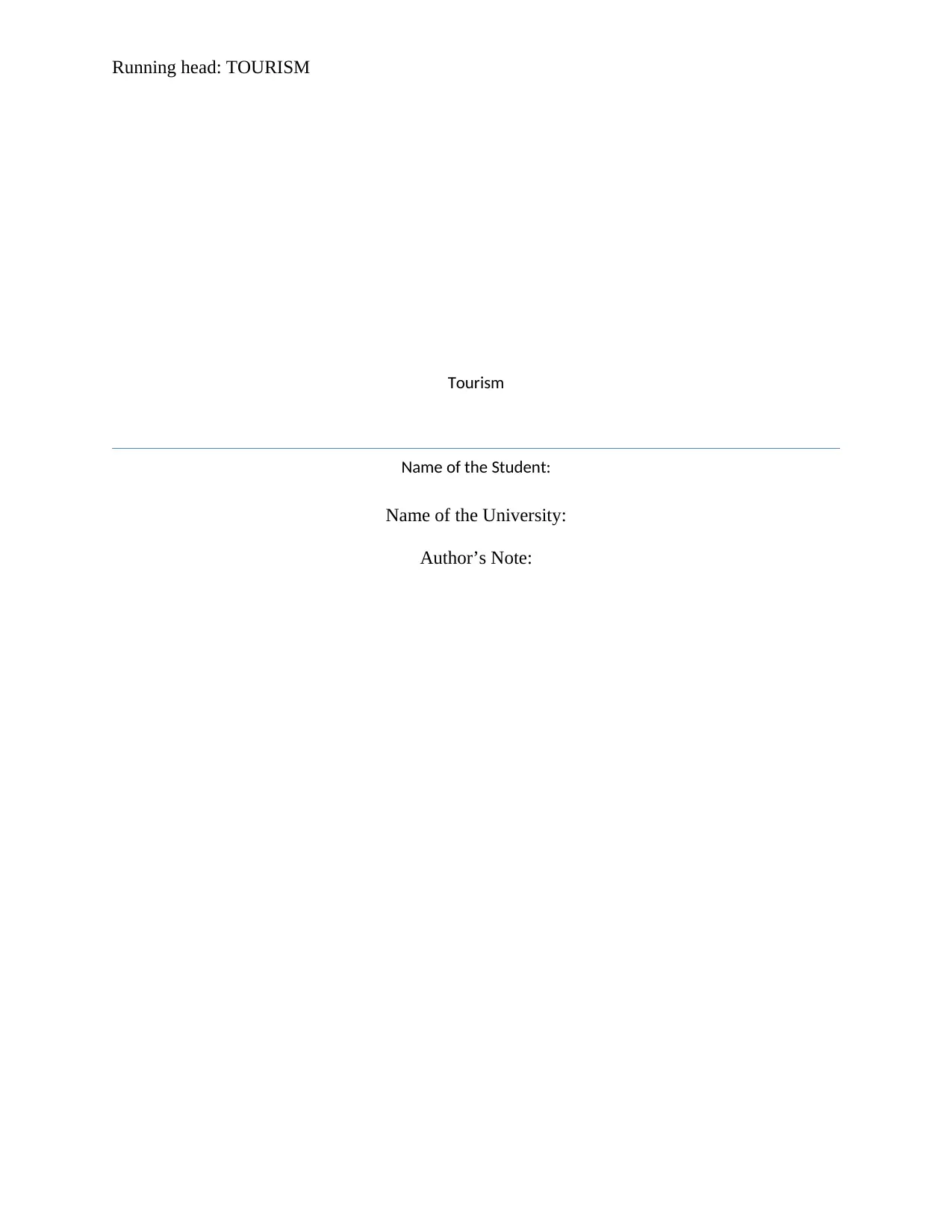
Running head: TOURISM
Tourism
Name of the Student:
Name of the University:
Author’s Note:
Tourism
Name of the Student:
Name of the University:
Author’s Note:
Paraphrase This Document
Need a fresh take? Get an instant paraphrase of this document with our AI Paraphraser
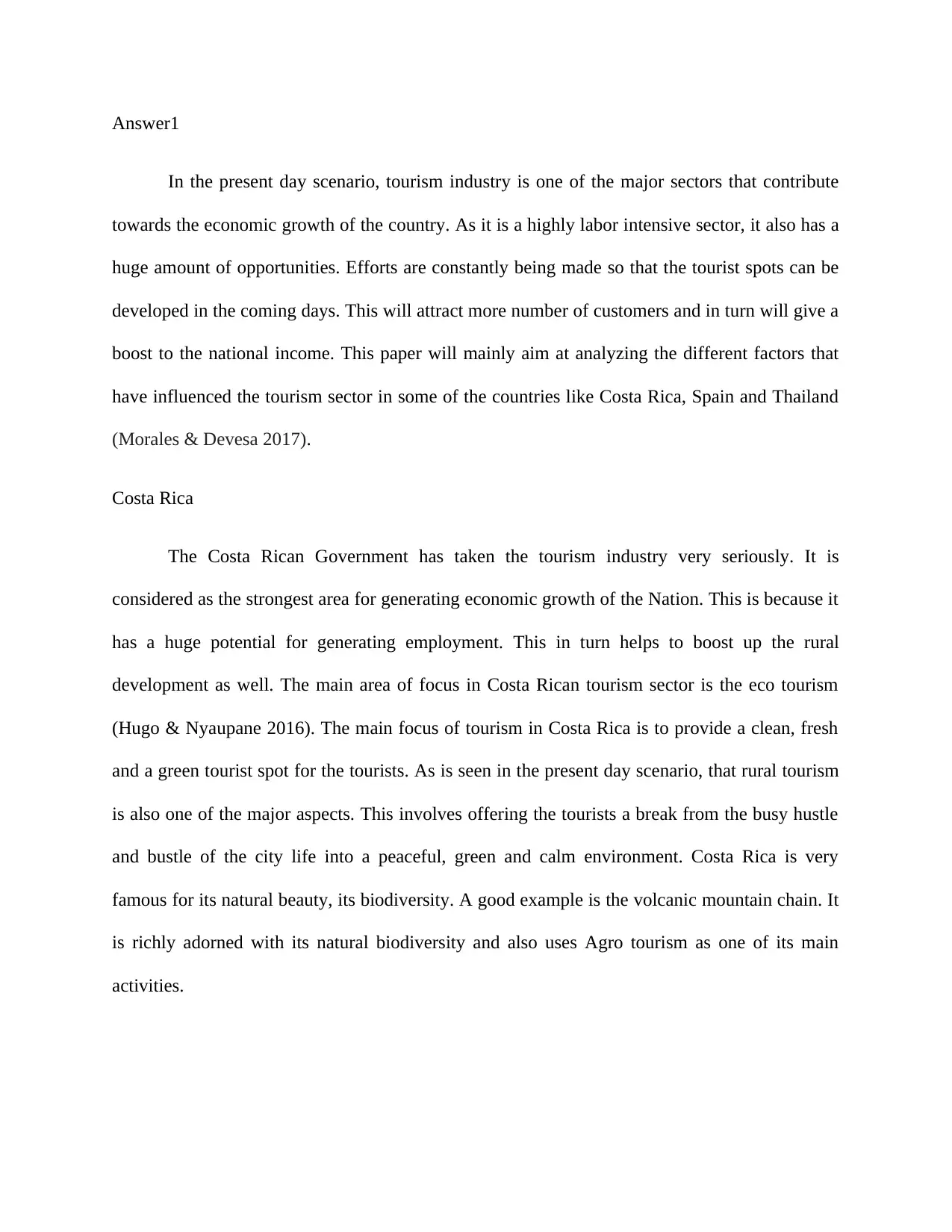
Answer1
In the present day scenario, tourism industry is one of the major sectors that contribute
towards the economic growth of the country. As it is a highly labor intensive sector, it also has a
huge amount of opportunities. Efforts are constantly being made so that the tourist spots can be
developed in the coming days. This will attract more number of customers and in turn will give a
boost to the national income. This paper will mainly aim at analyzing the different factors that
have influenced the tourism sector in some of the countries like Costa Rica, Spain and Thailand
(Morales & Devesa 2017).
Costa Rica
The Costa Rican Government has taken the tourism industry very seriously. It is
considered as the strongest area for generating economic growth of the Nation. This is because it
has a huge potential for generating employment. This in turn helps to boost up the rural
development as well. The main area of focus in Costa Rican tourism sector is the eco tourism
(Hugo & Nyaupane 2016). The main focus of tourism in Costa Rica is to provide a clean, fresh
and a green tourist spot for the tourists. As is seen in the present day scenario, that rural tourism
is also one of the major aspects. This involves offering the tourists a break from the busy hustle
and bustle of the city life into a peaceful, green and calm environment. Costa Rica is very
famous for its natural beauty, its biodiversity. A good example is the volcanic mountain chain. It
is richly adorned with its natural biodiversity and also uses Agro tourism as one of its main
activities.
In the present day scenario, tourism industry is one of the major sectors that contribute
towards the economic growth of the country. As it is a highly labor intensive sector, it also has a
huge amount of opportunities. Efforts are constantly being made so that the tourist spots can be
developed in the coming days. This will attract more number of customers and in turn will give a
boost to the national income. This paper will mainly aim at analyzing the different factors that
have influenced the tourism sector in some of the countries like Costa Rica, Spain and Thailand
(Morales & Devesa 2017).
Costa Rica
The Costa Rican Government has taken the tourism industry very seriously. It is
considered as the strongest area for generating economic growth of the Nation. This is because it
has a huge potential for generating employment. This in turn helps to boost up the rural
development as well. The main area of focus in Costa Rican tourism sector is the eco tourism
(Hugo & Nyaupane 2016). The main focus of tourism in Costa Rica is to provide a clean, fresh
and a green tourist spot for the tourists. As is seen in the present day scenario, that rural tourism
is also one of the major aspects. This involves offering the tourists a break from the busy hustle
and bustle of the city life into a peaceful, green and calm environment. Costa Rica is very
famous for its natural beauty, its biodiversity. A good example is the volcanic mountain chain. It
is richly adorned with its natural biodiversity and also uses Agro tourism as one of its main
activities.
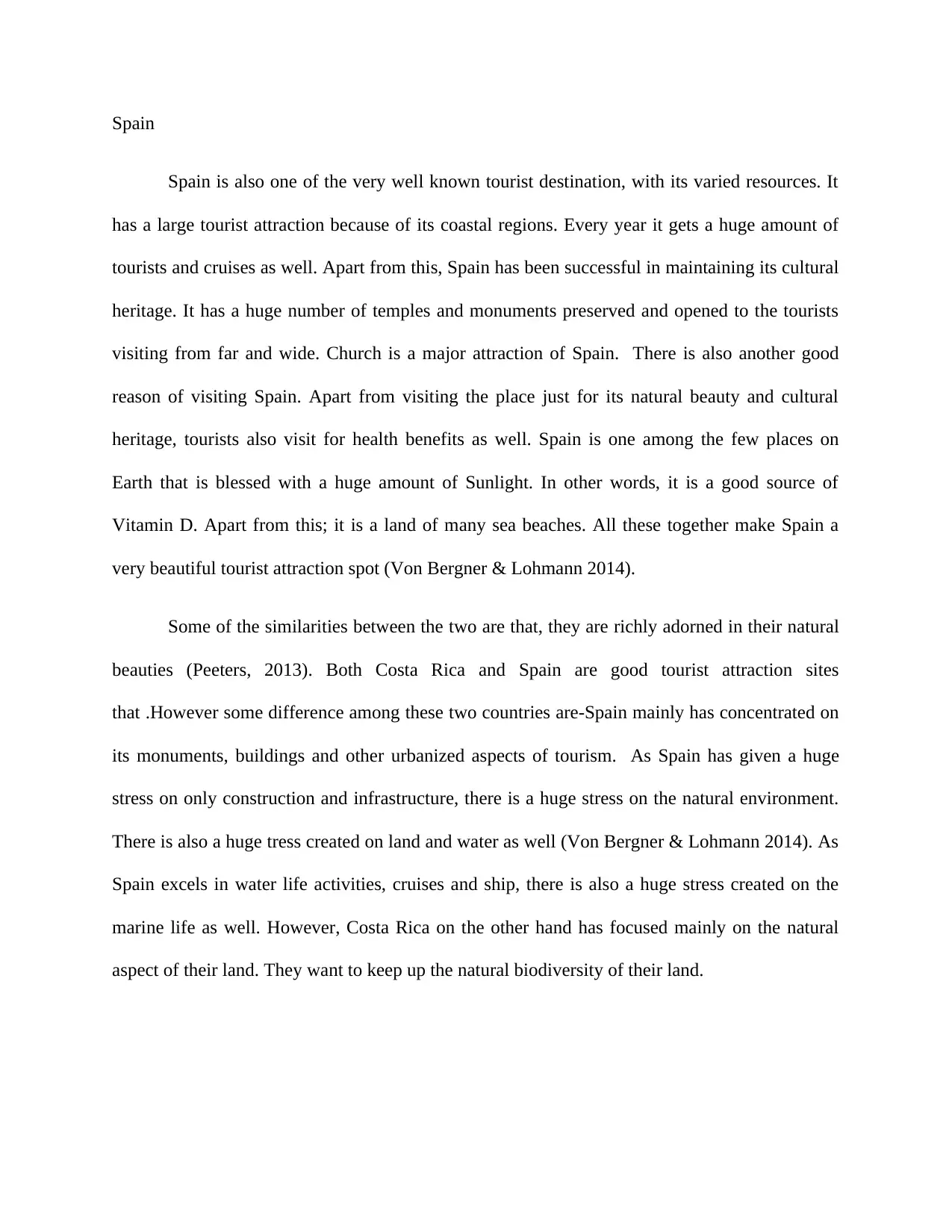
Spain
Spain is also one of the very well known tourist destination, with its varied resources. It
has a large tourist attraction because of its coastal regions. Every year it gets a huge amount of
tourists and cruises as well. Apart from this, Spain has been successful in maintaining its cultural
heritage. It has a huge number of temples and monuments preserved and opened to the tourists
visiting from far and wide. Church is a major attraction of Spain. There is also another good
reason of visiting Spain. Apart from visiting the place just for its natural beauty and cultural
heritage, tourists also visit for health benefits as well. Spain is one among the few places on
Earth that is blessed with a huge amount of Sunlight. In other words, it is a good source of
Vitamin D. Apart from this; it is a land of many sea beaches. All these together make Spain a
very beautiful tourist attraction spot (Von Bergner & Lohmann 2014).
Some of the similarities between the two are that, they are richly adorned in their natural
beauties (Peeters, 2013). Both Costa Rica and Spain are good tourist attraction sites
that .However some difference among these two countries are-Spain mainly has concentrated on
its monuments, buildings and other urbanized aspects of tourism. As Spain has given a huge
stress on only construction and infrastructure, there is a huge stress on the natural environment.
There is also a huge tress created on land and water as well (Von Bergner & Lohmann 2014). As
Spain excels in water life activities, cruises and ship, there is also a huge stress created on the
marine life as well. However, Costa Rica on the other hand has focused mainly on the natural
aspect of their land. They want to keep up the natural biodiversity of their land.
Spain is also one of the very well known tourist destination, with its varied resources. It
has a large tourist attraction because of its coastal regions. Every year it gets a huge amount of
tourists and cruises as well. Apart from this, Spain has been successful in maintaining its cultural
heritage. It has a huge number of temples and monuments preserved and opened to the tourists
visiting from far and wide. Church is a major attraction of Spain. There is also another good
reason of visiting Spain. Apart from visiting the place just for its natural beauty and cultural
heritage, tourists also visit for health benefits as well. Spain is one among the few places on
Earth that is blessed with a huge amount of Sunlight. In other words, it is a good source of
Vitamin D. Apart from this; it is a land of many sea beaches. All these together make Spain a
very beautiful tourist attraction spot (Von Bergner & Lohmann 2014).
Some of the similarities between the two are that, they are richly adorned in their natural
beauties (Peeters, 2013). Both Costa Rica and Spain are good tourist attraction sites
that .However some difference among these two countries are-Spain mainly has concentrated on
its monuments, buildings and other urbanized aspects of tourism. As Spain has given a huge
stress on only construction and infrastructure, there is a huge stress on the natural environment.
There is also a huge tress created on land and water as well (Von Bergner & Lohmann 2014). As
Spain excels in water life activities, cruises and ship, there is also a huge stress created on the
marine life as well. However, Costa Rica on the other hand has focused mainly on the natural
aspect of their land. They want to keep up the natural biodiversity of their land.
⊘ This is a preview!⊘
Do you want full access?
Subscribe today to unlock all pages.

Trusted by 1+ million students worldwide
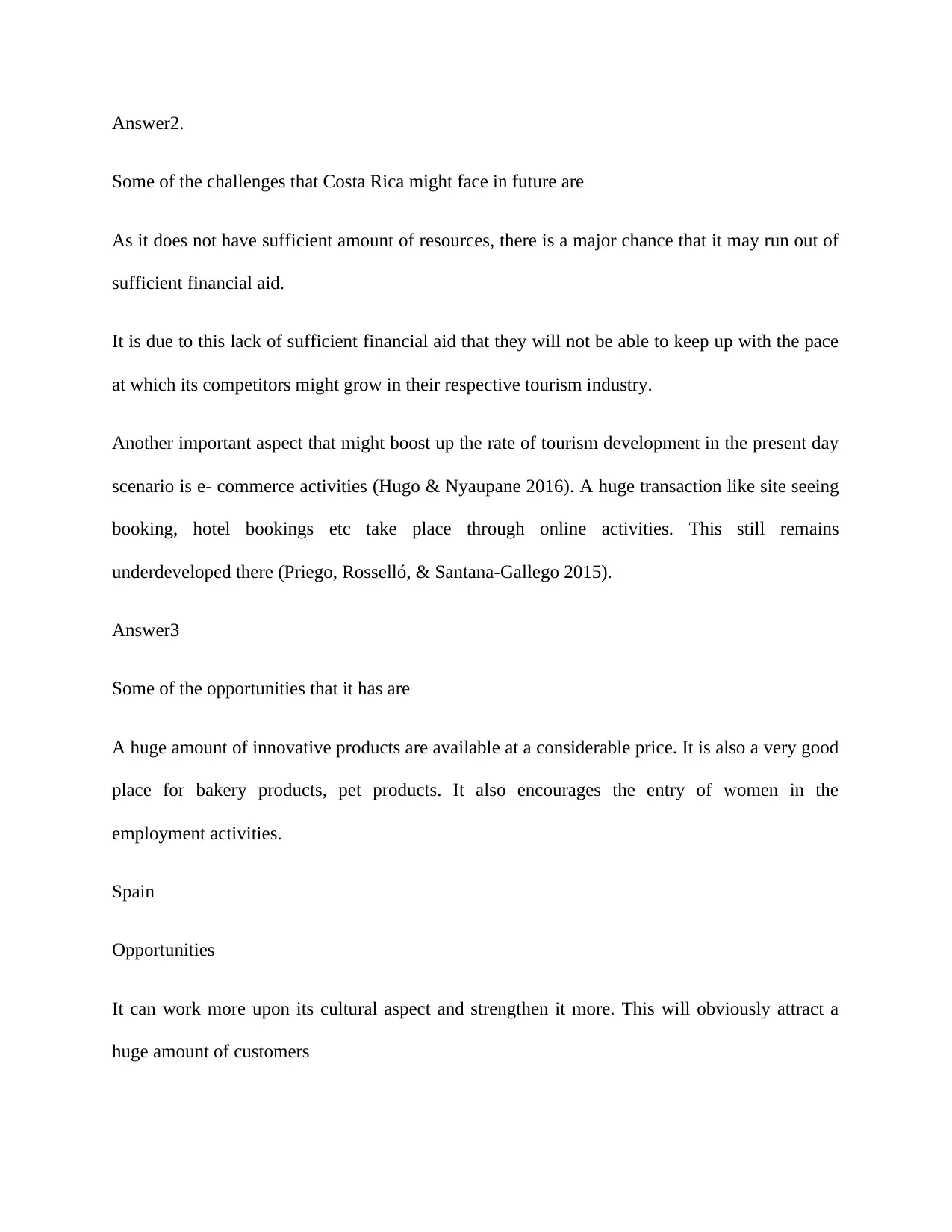
Answer2.
Some of the challenges that Costa Rica might face in future are
As it does not have sufficient amount of resources, there is a major chance that it may run out of
sufficient financial aid.
It is due to this lack of sufficient financial aid that they will not be able to keep up with the pace
at which its competitors might grow in their respective tourism industry.
Another important aspect that might boost up the rate of tourism development in the present day
scenario is e- commerce activities (Hugo & Nyaupane 2016). A huge transaction like site seeing
booking, hotel bookings etc take place through online activities. This still remains
underdeveloped there (Priego, Rosselló, & Santana-Gallego 2015).
Answer3
Some of the opportunities that it has are
A huge amount of innovative products are available at a considerable price. It is also a very good
place for bakery products, pet products. It also encourages the entry of women in the
employment activities.
Spain
Opportunities
It can work more upon its cultural aspect and strengthen it more. This will obviously attract a
huge amount of customers
Some of the challenges that Costa Rica might face in future are
As it does not have sufficient amount of resources, there is a major chance that it may run out of
sufficient financial aid.
It is due to this lack of sufficient financial aid that they will not be able to keep up with the pace
at which its competitors might grow in their respective tourism industry.
Another important aspect that might boost up the rate of tourism development in the present day
scenario is e- commerce activities (Hugo & Nyaupane 2016). A huge transaction like site seeing
booking, hotel bookings etc take place through online activities. This still remains
underdeveloped there (Priego, Rosselló, & Santana-Gallego 2015).
Answer3
Some of the opportunities that it has are
A huge amount of innovative products are available at a considerable price. It is also a very good
place for bakery products, pet products. It also encourages the entry of women in the
employment activities.
Spain
Opportunities
It can work more upon its cultural aspect and strengthen it more. This will obviously attract a
huge amount of customers
Paraphrase This Document
Need a fresh take? Get an instant paraphrase of this document with our AI Paraphraser
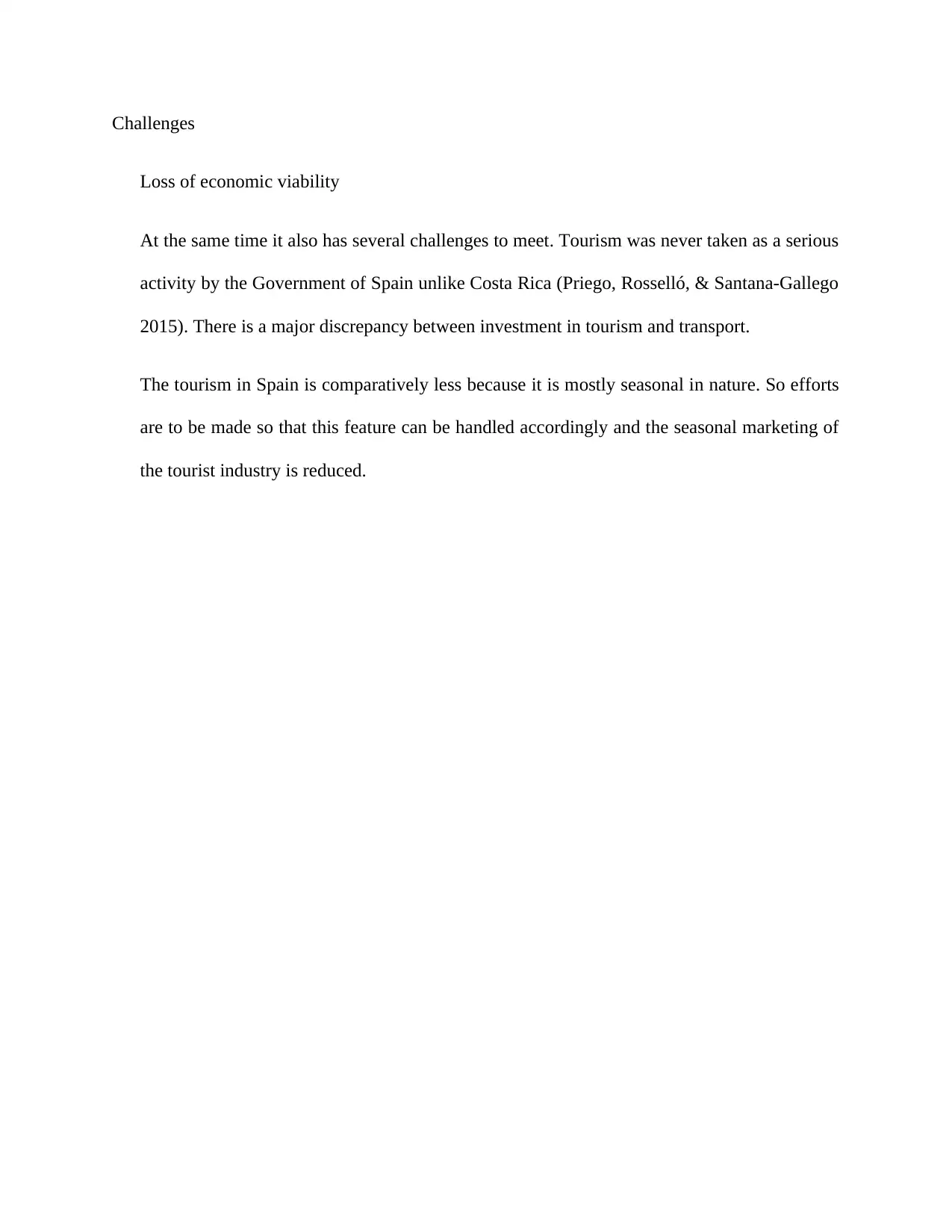
Challenges
Loss of economic viability
At the same time it also has several challenges to meet. Tourism was never taken as a serious
activity by the Government of Spain unlike Costa Rica (Priego, Rosselló, & Santana-Gallego
2015). There is a major discrepancy between investment in tourism and transport.
The tourism in Spain is comparatively less because it is mostly seasonal in nature. So efforts
are to be made so that this feature can be handled accordingly and the seasonal marketing of
the tourist industry is reduced.
Loss of economic viability
At the same time it also has several challenges to meet. Tourism was never taken as a serious
activity by the Government of Spain unlike Costa Rica (Priego, Rosselló, & Santana-Gallego
2015). There is a major discrepancy between investment in tourism and transport.
The tourism in Spain is comparatively less because it is mostly seasonal in nature. So efforts
are to be made so that this feature can be handled accordingly and the seasonal marketing of
the tourist industry is reduced.
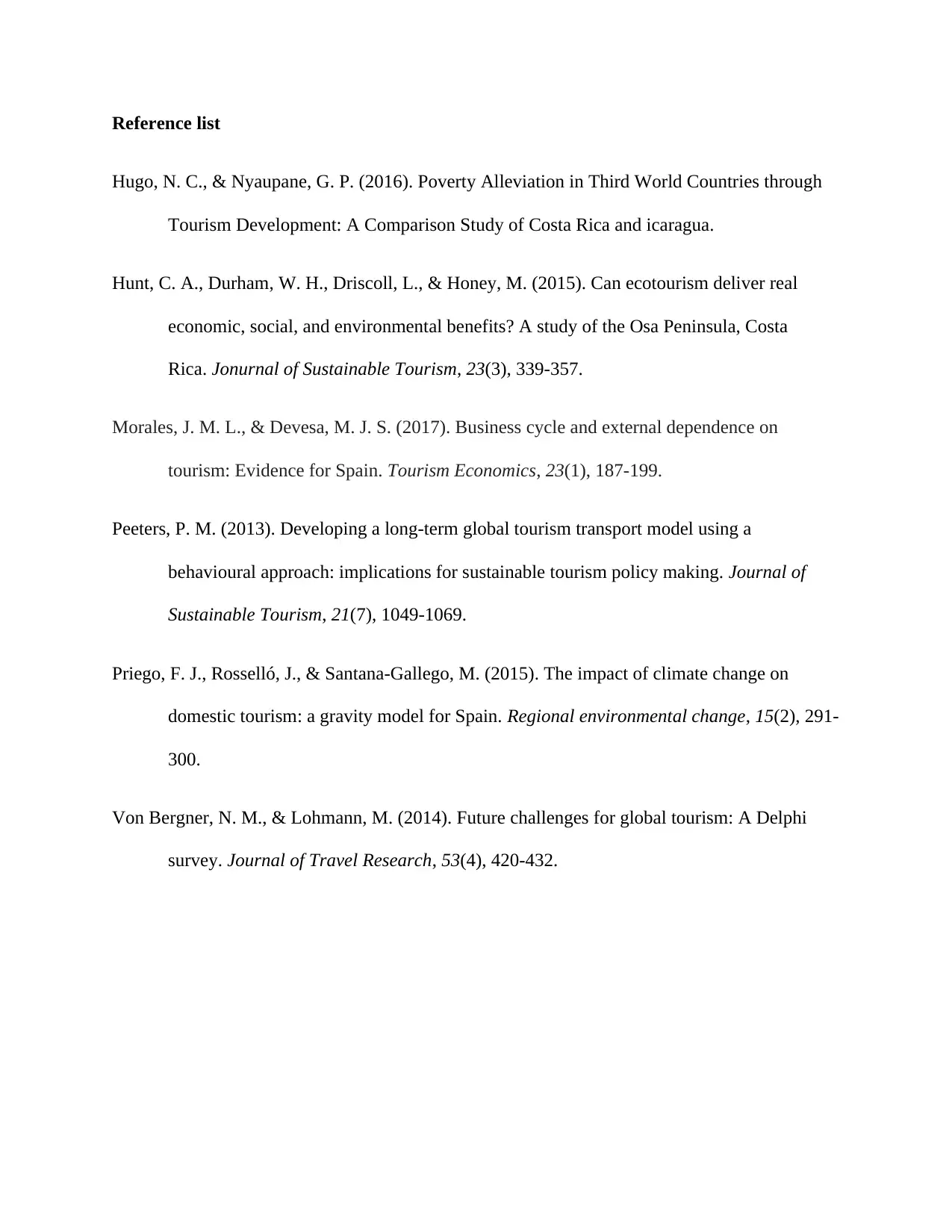
Reference list
Hugo, N. C., & Nyaupane, G. P. (2016). Poverty Alleviation in Third World Countries through
Tourism Development: A Comparison Study of Costa Rica and icaragua.
Hunt, C. A., Durham, W. H., Driscoll, L., & Honey, M. (2015). Can ecotourism deliver real
economic, social, and environmental benefits? A study of the Osa Peninsula, Costa
Rica. Jonurnal of Sustainable Tourism, 23(3), 339-357.
Morales, J. M. L., & Devesa, M. J. S. (2017). Business cycle and external dependence on
tourism: Evidence for Spain. Tourism Economics, 23(1), 187-199.
Peeters, P. M. (2013). Developing a long-term global tourism transport model using a
behavioural approach: implications for sustainable tourism policy making. Journal of
Sustainable Tourism, 21(7), 1049-1069.
Priego, F. J., Rosselló, J., & Santana-Gallego, M. (2015). The impact of climate change on
domestic tourism: a gravity model for Spain. Regional environmental change, 15(2), 291-
300.
Von Bergner, N. M., & Lohmann, M. (2014). Future challenges for global tourism: A Delphi
survey. Journal of Travel Research, 53(4), 420-432.
Hugo, N. C., & Nyaupane, G. P. (2016). Poverty Alleviation in Third World Countries through
Tourism Development: A Comparison Study of Costa Rica and icaragua.
Hunt, C. A., Durham, W. H., Driscoll, L., & Honey, M. (2015). Can ecotourism deliver real
economic, social, and environmental benefits? A study of the Osa Peninsula, Costa
Rica. Jonurnal of Sustainable Tourism, 23(3), 339-357.
Morales, J. M. L., & Devesa, M. J. S. (2017). Business cycle and external dependence on
tourism: Evidence for Spain. Tourism Economics, 23(1), 187-199.
Peeters, P. M. (2013). Developing a long-term global tourism transport model using a
behavioural approach: implications for sustainable tourism policy making. Journal of
Sustainable Tourism, 21(7), 1049-1069.
Priego, F. J., Rosselló, J., & Santana-Gallego, M. (2015). The impact of climate change on
domestic tourism: a gravity model for Spain. Regional environmental change, 15(2), 291-
300.
Von Bergner, N. M., & Lohmann, M. (2014). Future challenges for global tourism: A Delphi
survey. Journal of Travel Research, 53(4), 420-432.
⊘ This is a preview!⊘
Do you want full access?
Subscribe today to unlock all pages.

Trusted by 1+ million students worldwide
1 out of 6
Related Documents
Your All-in-One AI-Powered Toolkit for Academic Success.
+13062052269
info@desklib.com
Available 24*7 on WhatsApp / Email
![[object Object]](/_next/static/media/star-bottom.7253800d.svg)
Unlock your academic potential
Copyright © 2020–2025 A2Z Services. All Rights Reserved. Developed and managed by ZUCOL.




